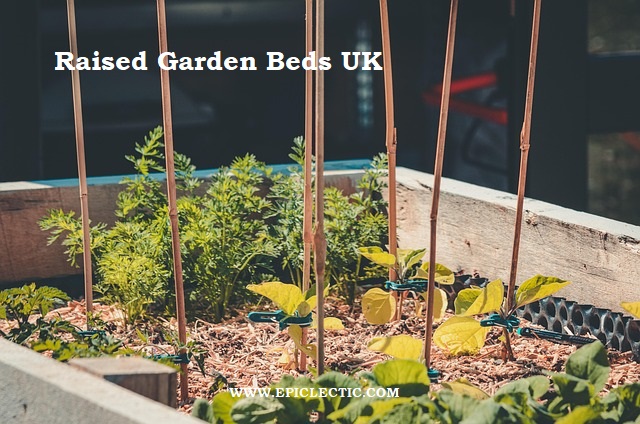Raised garden beds UK are a popular and practical choice for gardeners across the UK, especially in places like Loughborough, where space, soil quality, and weather can vary.
From improving drainage to reducing weeds and making gardening more accessible, raised beds have many advantages. But with so many sizes, materials, and options available, it’s important to choose the right one for your needs and budget.
In this complete guide, you’ll learn what raised garden beds UK are, how they work, what materials are best, where to buy them in the UK, and even how to build your own. Let’s get started.
What Is a Raised Garden Beds UK and How Does It Work?
Raised garden beds UK is a contained, elevated gardening area where you grow plants above ground level in a specially prepared mix of soil and compost. It’s like a giant planter box without a bottom, allowing roots to grow deep into enriched, well-drained soil.
Raised beds are usually made from plastic, metal, or woods. They may come in different shapes and sizes. You can place them directly on soil, grass, patios, or even concrete. Here’s how raised beds work in practice:
You fill the frame with soil that is generally a mixture of compost and organic matter. Because the soil is above ground, it warms faster in spring and drains better after rain. Plants have fewer issues with compaction, poor drainage, or rocky native soil.
Think of a raised garden bed as a “fresh start” for your plants free from weeds, pests, or poor soil. They’re perfect for urban gardens, balconies, or anyone looking to get the most from a small space.
A raised garden bed is a freestanding garden box filled with soil, lifted above ground level. It works by giving plants better drainage, warmer soil, and easier access, which is ideal for the UK’s unpredictable weather and heavy soils.
Key Benefits of Raised Garden Beds UK
Raised garden beds UK offer multiple benefits for UK gardeners—especially in areas with heavy clay soil, unpredictable weather, or small outdoor spaces like patios or yards. They’re not just practical, they can also make gardening easier, more productive, and even more enjoyable.
- Better Drainage
Because the soil in raised garden beds UK is elevated, excess water drains more easily than in traditional ground-level beds. This is especially helpful in the UK, where rain can be frequent and unpredictable.
- Warmer Soil- Earlier Planting
Raised garden beds UK becomes warm quickly in the spring, allowing you to plant earlier in the season. The extra warmth also helps seeds germinate quicker and can extend the growing season by a few weeks.
- Less Weeding and Pests
Filling a raised bed with fresh soil means fewer weed seeds and garden pests to start with. Adding a barrier underneath can also help block invasive weeds and burrowing pests like slugs or moles.
- Easier on Your Back and Knees
Because raised garden beds uk are elevated, you don’t need to bend as much when planting, weeding, or harvesting. This makes them perfect for older gardeners or anyone with limited mobility.
- Better Soil Quality
You control the soil mix inside your raised bed, so it’s often more fertile and better draining than native garden soil. This gives more yields and raise healthy plants.
- Ideal for Small or Urban Spaces
If you live in a flat, townhouse, or have limited outdoor space, raised garden beds UK let you garden in compact areas like patios, balconies, or even rooftops.
Top 5 Benefits of Raised Garden Beds UK
|
Benefit |
Why It Matters in the UK |
|
Improved Drainage |
Helps avoid soggy soil and root rot during wet months |
|
Custom Soil Mix |
Allows better control for specific plants |
|
Accessibility |
Great for older adults or limited mobility |
|
Extended Season |
Start planting earlier with warmer soil |
|
Less Weeding |
Easier to maintain and protect from pests |
Types of Raised Garden Beds UK (With Pros and Cons)
Raised garden beds UK has its own pros and cons based on cost, durability, appearance, and maintenance. Choosing the right one depends on your budget, space, and gardening goals.
Below are the most common types of raised garden beds UK available to gardeners:
Wooden Raised Beds
Wood is the most popular material for raised beds in UK gardens.
Pros:
- Affordable and widely available (e.g., B&Q, Wickes, local timber yards)
- Natural look that blends with garden aesthetics
- Easy to build as a DIY project
Cons:
- Can rot over time, especially untreated softwood
- Needs maintenance (e.g., applying linseed oil or using treated wood)
Use pressure-treated wood marked as safe for gardening, or choose hardwoods like cedar or larch for longer durability.
Metal Raised Beds
Metal beds (usually made from galvanized steel or zinc-coated panels) offer a modern, industrial look and long-lasting performance.
Pros:
- Extremely durable and weather-resistant
- Doesn’t rot, warp, or crack
- Sleek appearance suitable for modern garden designs
Cons:
- More expensive than wood or plastic
- Can heat up quickly in strong sun (less of a problem in the UK, but worth noting)
- May require gloves during assembly due to sharp edges
Plastic or Recycled Composite Beds
Plastic raised beds, especially those made from recycled materials, are low-maintenance and lightweight.
Pros:
- Rot-proof and weather-resistant
- Often made from eco-friendly recycled plastics
- Lightweight and easy to move
Cons:
- May not look as natural in traditional garden settings
- Can be more expensive than wood
- Some plastic models can fade or warp over time
Sleeper-Style or Upcycled Beds
These are often built using railway sleepers, reclaimed bricks, or other upcycled materials.
Pros:
- Very strong and rustic in appearance
- Sustainable and often budget-friendly
- Allows for deep beds—great for root crops
Cons:
- Very heavy and harder to move
- May require tools and experience to build
- Old sleepers may contain tar or creosote, avoid unless certified safe
For wet UK gardens, choose a raised bed made from galvanised steel or treated wood, at least 12 inches deep, and place it in a sunny, well-drained spot. Always match the size and depth to what you plan to grow.
How to Choose the Right Size and Depth for Your Garden
The right size and depth of your raised garden bed depend on what you plan to grow, surrounding, and your physical comfort. A bed that’s too shallow won’t support healthy roots, while one that’s too wide might be hard to reach across.
Ideal Width
- Keep your raised bed no wider than 4 feet (1.2 metres).
- This helps to reach the centre from the sides which is important for keeping it loose and aerated.
- Standard width: 3–4 feet (90–120 cm)
- Narrow patios/balconies: 1–2 feet (30–60 cm)
Ideal Length
Length can vary depending on space, but common options include 4, 6, and 8 feet (1.2m, 1.8m, and 2.4m).
There’s no limit to how long your bed can be, but be sure it’s accessible from the sides or broken up with paths if very long.
Ideal Depth
Most raised beds should be minimum 6–12 inches (15–30 cm) deep. However, some plants—like root vegetables or courgettes—need more room to grow.
|
Crop Type |
Minimum Bed Depth |
|
Leafy greens/herbs |
6–8 inches (15–20 cm) |
|
Tomatoes/courgettes |
12–18 inches (30–45 cm) |
|
Carrots/parsnips |
18–24 inches (45–60 cm)
|
Best Soil and Compost for Raised Garden Beds UK
The secret to a productive raised bed lies in the soil, it should be rich, well-draining, and full of nutrients. In the UK, many native soils are clay-heavy or too compacted, making custom soil mixes ideal for raised garden beds UK.
Ideal Soil Mix (UK Raised Bed Recipe)
Use a 50/30/20 blend for most raised beds:
- 50% topsoil – Bulk bags or screened topsoil from garden centres
- 30% compost – Homemade or peat-free organic compost
- 20% soil conditioner – Well-rotted manure, leaf mould, or coconut coir
This mix balances nutrients, texture, and drainage—perfect for growing UK-friendly vegetables and flowers.
Peat-Free and Organic Options
Go peat-free whenever possible. It’s better for the environment and still provides excellent structure and nutrients.
Great UK peat-free brands include:
- Dalefoot Compost
- Westland New Horizon
- Melcourt SylvaGrow
How to Build a DIY Raised Bed (Step-by-Step Guide)
Building your own raised garden beds UK is affordable, beginner-friendly, and only takes a couple of hours with basic tools. If you want a custom size or just love a weekend garden project, here’s a simple method using wooden boards.
What You’ll Need
- 4 wooden boards (e.g. 1.2m x 30cm for a 4ft x 1ft bed)
- Galvanised screws or corner brackets
- Electric drill or screwdriver
- Weed membrane or cardboard (for lining)
- Soil and compost (see previous section)
- Optional: Corner posts (for extra height or stability), liner if placing on concrete
Step-by-Step Instructions
Step 1: Choose a Flat, Sunny Spot
Pick a land where sunlight is available for at least 6–8 hours per day. Clear weeds or grass from the space.
Step 2: Prepare The Wood
Use treated timber, hardwood, or durable planks. Cut to your desired length and height.
Step 3: Assemble the Frame
Screw the boards together at the corners to form a rectangle shape. Use brackets or stakes for added strength.
Step 4: Line the Base (Optional but Recommended)
Lay cardboard or weed fabric at the bottom to block weeds and encourage worms.
Step 5: Fill with Soil Mix
Add your 50/30/20 soil-compost-conditioner mix. Level the top.
Step 6: Water and Plant
Watering helps the soil to settle, so do it properly and then start planting!
Best Crops to Grow in Raised Garden Beds UK Climate
Raised garden beds UK are perfect for raising plenty of vegetables, fruits, and herbs, especially in the UK’s cool and sometimes wet climate. Because you control the soil and drainage, you can grow more successfully than in open ground.
Top Vegetables for Raised Garden Beds UK
These crops thrive in raised beds due to better drainage, warmer soil, and easy access:
- Lettuce & Salad Leaves – Quick-growing and ideal for shallow beds.
- Carrots & Parsnips – Need deep, loose soil, raised beds are perfect.
- Tomatoes – Raised beds help with warmth and drainage.
- Courgettes & Squash – Love rich, well-fed soil.
- Runner Beans & Peas – Use vertical supports in your bed for climbing.
Herbs That Love Raised Garden Beds UK
- Basil, Parsley, Thyme, Chives – Easy to manage and snip fresh as needed.
- Mint – Best grown in a pot inside the raised bed to stop it spreading.
Fruits You Can Grow
- Strawberries – Do very well in raised beds or hanging baskets.
- Raspberries – Grow in deeper beds with support at the back.
- Rhubarb – Thrives in rich soil with space to spread.
Raised garden beds UK are perfect for growing salad leaves, carrots, radishes, spinach, strawberries, and courgettes. These crops thrive in well-drained, warmer soil—making the most of the UK’s short growing season.
Maintenance Tips: Keeping Your Raised Garden Beds UK Healthy Year-Round
Raised garden beds UK need regular care to stay productive, weed-free, and nutrient-rich. Fortunately, a few simple habits can keep your beds thriving season after season—even through the unpredictable British weather.
- Weed Regularly and Mulch
Remove weeds by hand or with a hoe every week. Add a layer of organic mulch such as straw, bark, or compost. It would suppress inconvenient weeds and retain much moisture. Mulching also improves soil quality over time.
- Water Wisely (Especially in Summer)
Check soil daily in warm months; water when the top 2 inches feel dry. Use a soaker hose or watering can to avoid splashing leaves (reduces disease risk). Morning watering is best to prevent mildew and slugs.
- Feed the Soil
Top up with compost or well-rotted manure every spring and autumn. Use liquid seaweed feed or comfrey tea during heavy growth periods. Rotate crops each season to prevent soil exhaustion.
- Control Pests Naturally
Use copper tape around bed edges to stop slugs. Attract helpful predators like ladybirds by planting marigolds or nasturtiums. Net your crops to stop pigeons and cabbage white butterflies.
- Winter Bed Prep
Remove dead plants after the season ends. Add a crop that would cover or mulch heavily to protect the soil. Consider covering your bed with fleece or polythene to reduce nutrient leaching.
Common Mistakes to Avoid with Raised Garden Beds UK
Knowing what not to do can save you time, money, and frustration when starting or maintaining raised garden beds UK. Here are some common mistakes UK gardeners make—and how to avoid them.
Mistake 1: Using Poor-Quality or Untreated Wood
Untreated wood can rot quickly in the damp UK climate. Always use pressure-treated, cedar, or larch timber for durability. Avoid any kind of chemically treated wood in case you are trying to grow edible plants, look for food-safe certification.
Mistake 2: Making Beds Too Wide or Hard to Reach
Beds wider than 4 feet make planting and harvesting difficult. Ensure you can comfortably reach the centre from either side.
Mistake 3: Skipping Soil Preparation
Filling beds with poor soil or garden soil leads to poor plant health. Use a custom soil mix (topsoil, compost, conditioner) for best results.
Mistake 4: Overwatering or Poor Drainage
Raised beds improve drainage, but overwatering can drown roots. Always monitor soil moisture. Only give water when needed.
FAQs
- How do I protect raised beds from pests?
Use copper tape for slugs, netting for birds and insects, and companion planting to attract beneficial insects.
- How do I prevent raised beds from drying out?
Apply organic mulch and water in the mornings to retain moisture.
- Can raised beds improve soil quality?
Yes, they allow you to control soil composition, improving drainage and nutrients.
- How often should I add compost to my raised beds?
Add compost every spring and autumn for best soil health.
- How do I prepare a raised bed for winter?
Clear plants, add mulch or cover crops, and protect soil with fleece if needed.
- Can I use weed membranes under raised beds?
Yes, to reduce weeds, but some gardeners prefer organic layers like cardboard for soil health.
- How long do raised beds last?
With treated wood or durable materials, raised beds can last 10+ years.
- Are metal raised garden beds better than wood?
Metal beds last longer and resist rot but may heat soil more in summer.
- Can I grow plants other than vegetables in raised beds?
Yes, flowers, herbs, and even small shrubs do well.
- How do I avoid waterlogging in raised beds?
Ensure good drainage by using quality soil mix and avoid overwatering.
Conclusion
Raised garden beds UK offer an excellent way for gardeners in the UK, including Loughborough, to grow healthier plants with better soil control and drainage. By choosing the right soil mix, buying quality materials, and following simple maintenance tips, you’ll enjoy a thriving garden all year round.
Whether you build your own raised bed or buy a ready-made one, the key is to plan thoughtfully: select the best location, pick crops suited to the UK climate, and maintain your beds regularly.




